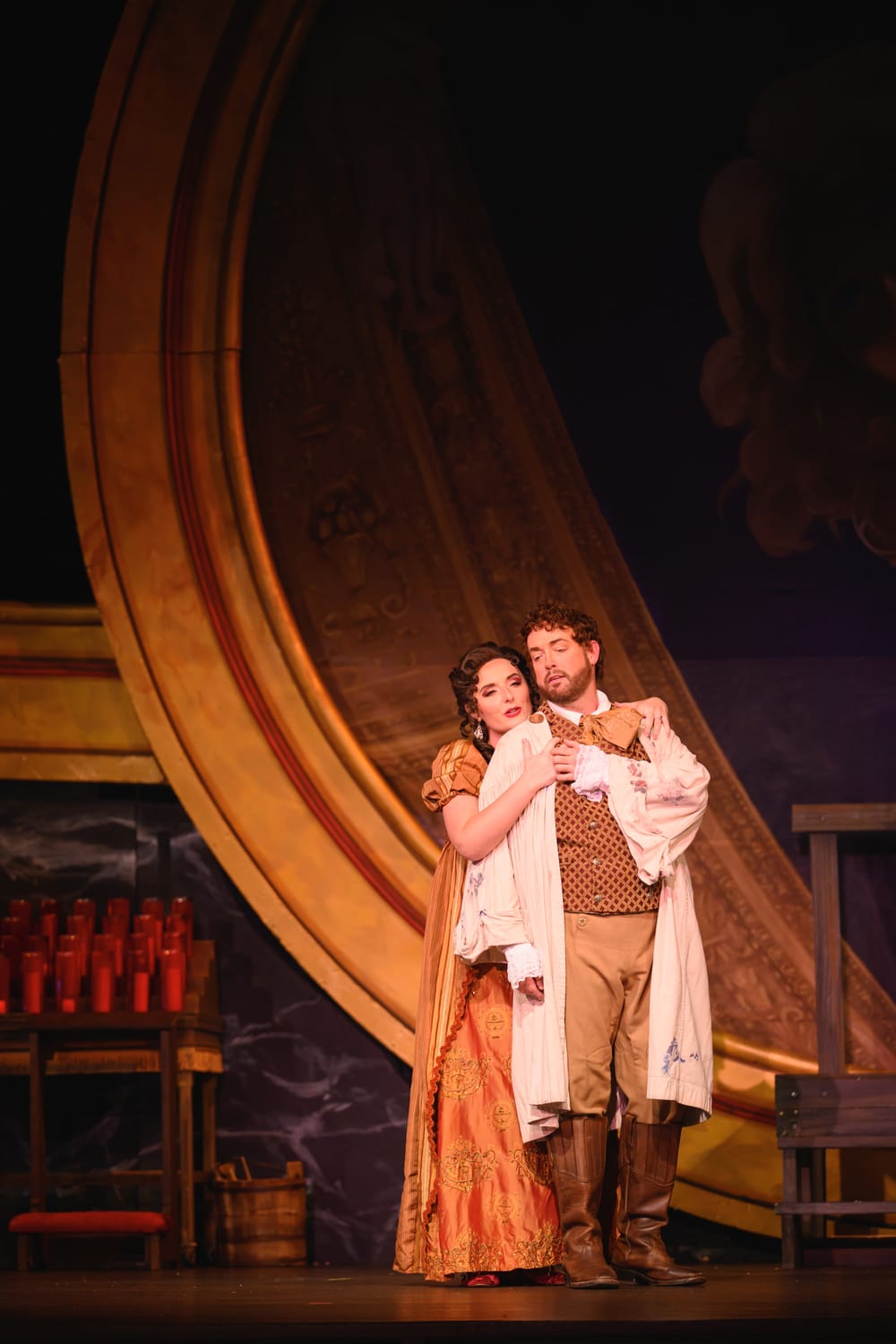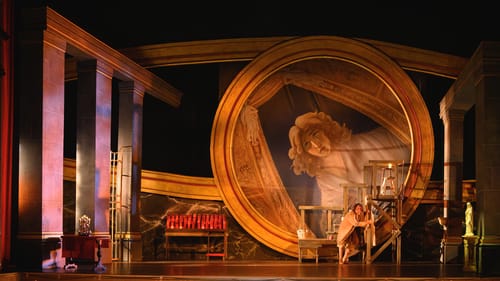Stay in the Loop
BSR publishes on a weekly schedule, with an email newsletter every Wednesday and Thursday morning. There’s no paywall, and subscribing is always free.
An opera masterwork remains timeless
OperaDelaware presents Puccini’s Tosca

For all of its two centuries, Tosca has been a regular part of the operatic canon. Some operas are most cogently related to the era when they were written or set. But this masterwork remains timeless, evidenced by OperaDelaware’s recent stirring production.
Giacomo Puccini (1858-1924) had two lackluster operatic forays, but on his third try, he mined gold with the tightly structured, sensational three-act Tosca. As with many of the era’s composers, when searching for a narrative on which to build his composition, Puccini turned to a contemporary stage hit: La Tosca by French playwright Victorien Sardou.
Sardou, a sensation in his time but never produced today, wrote this 1887 work about an operatic diva for Sarah Bernhardt, who performed it more than 200 times in Paris and on tour. When Puccini saw the great actor in Sardou’s play, he and his publisher secured the rights to the work, a process as complex then as now.
Artistry, romance, politics, and evil
Puccini’s Tosca premiered in 1900 in Rome, but the composer set it a century earlier against the backdrop of Italy’s political unrest. The story centers on two artists: the famous singer Floria Tosca (soprano Emily Margevich in her role debut) and her lover, the well-known painter Cavaradossi (tenor John Pickle). They are thwarted by the machinations of one of the great operatic villains, the heinous and mercurial Scarpia (baritone Steven Condy).
When political prisoner (and actual historical figure), Cesare Angelotti (baritone Gerard Moon), escapes, he seeks refuge in the Roman Church of Sant’Andrea della Valle, where Cavaradossi is painting a fresco of Mary Magdalene. The painter agrees to help the fugitive escape the police, but to no avail. He is captured, the painter who harbored him is tortured and killed (no spoilers in a plot this well-known), and the lascivious Scarpia attempts a devilish bargain with Tosca, who tragically leaps to her death off the ramparts of Rome’s Castel Sant’Angelo.
The cogently developed, satisfyingly melodramatic plot is the work of two librettists: Luigi Illica, who wrote the prose text, and Giuseppe Giacosa, who put the prose into poetry. The opera’s three acts revolve around sublime artistry, romantic relationships, complex politics, and the power of evil, reasons that the work has resonated with operatic audiences both faithful and new.
Unassailable reasons to sing
Like Shakespeare, Puccini leavens his plot with comedy, here an officious, sneezing, busy church sacristan (Brian James Myer), seen as the curtain rises, whose work cleaning and maintaining order is constantly interrupted by visitors (devout and profane).
The character of Floria Tosca is the perfect operatic lead, a character who has an unassailable reason to sing. Puccini seamlessly knits together drama and music, and those singing this iconic character must convey sublime artistic expertise and star magnetism. In her role debut, Margevich is winningly convincing. In the first act, she is a mercurial, flirtatious, self-centered diva, jealously teasing Cavaradossi as she prepares for that night’s concert. But there are ample hints of the steely, uncompromising core that will see her through the opera’s tragic finale.

This verismo opera is through-composed, meaning that there are few times when the musical action stops for character revelation. Tosca’s famous, plaintive Act II aria, Vissi d’arte (I lived for art), is a great one, exquisitely sung and heartbreakingly acted by Margevich. Puccini gives two arias to his hero, Cavaradossi: “Recondita armonia (Concealed harmony)” in Act I, when the painter compares Tosca to the portrait he is painting, and “E lucevan le stelle (The stars were shining)” as he faces death in Act III. Both were beautifully realized by Pickle, whose supple tenor is underscored by his range and emotional fire.
The opera’s villainous centerpiece is the great baritone role of Scarpia, sung by Condy in a tour de force whirl of heft and malevolence. Noted for his astute comic characterizations, here this exceptionally fine singer also excelled as the perfect villain, full of lust and rage, and both applauded and booed at the curtain call.
Expertly satisfying
Conductor Domenico Boyagian led the orchestra confidently, and they gained in strength throughout the evening, rising to match the accomplished company. Comprimario roles were ably sung throughout, Moon and Myer among the standouts. Chorus master George Hemcher’s excellent ensemble sings onstage only in Act I, though they are heard offstage later and also double as non-singing characters throughout.
Director Haley Stamats had the task of staging Tosca in two different houses. OperaDelaware and Opera Baltimore are frequent partners, and this production appeared in Baltimore the previous week. She gave it a distinctly melodramatic flair, but with a few curious touches. Supertitles were often inexpertly translated, and the soldiers in Act III seemed to wander aimlessly on the castle’s ramparts. Also, at the end of Act I, as Scarpia sings of his desire to possess Tosca, the diva (clad in a diaphanous gown) appears in a hot halo of golden light that upstages Scarpia’s increasing malevolence and Condy’s fine, forceful singing.
Puccini set this opera’s three acts in real locales that he scouted by wandering throughout Rome. Depictions of the famous Roman church (Act I), Scarpia’s Palazzo Farnese apartment (a devil’s den of black and gray and shadowy corners), and the ramparts of the city’s castle were beautifully rendered by scenic designer John Raley. They were equally beautifully lit by Tláloc López-Watermann, especially notable when you consider that these designers, too, had to configure the work for two different stages. Also notable was the work of Brittany Rappise, costume coordinator and hair/makeup designer. Scarpia’s evil persona was greatly enhanced by Rappise’s designs, and Tosca’s Empire-style gowns perfectly positioned her as a great diva.
Overall, this Tosca was a satisfying, expert production, a great hit with the audience, and a welcome indication of the company’s continuing artistry.
At top: Emily Margevigh as Floria Tosca and John Pickle as Mario Cavaradossi in OperaDelaware’s Tosca. (Photo by Joe del Tufo/Moonloop Photography.)
What, When, Where
Tosca. Music by Giacomo Puccini, libretto by Luigi Illica and Giuseppe Giacosa; conducted by Domenico Boyagian, stage direction by Haley Stamats, chorus mastery by George Hemcher. October 17 and 19, 2025, at the Grand Opera House's Copeland Stage, 818 N Market Street, Wilmington. (302) 442-7807 or operade.org.
Accessibility
The Grand has a street-level entrance and is a wheelchair-accessible venue.
Sign up for our newsletter
All of the week's new articles, all in one place. Sign up for the free weekly BSR newsletters, and don't miss a conversation.

 Gail Obenreder
Gail Obenreder